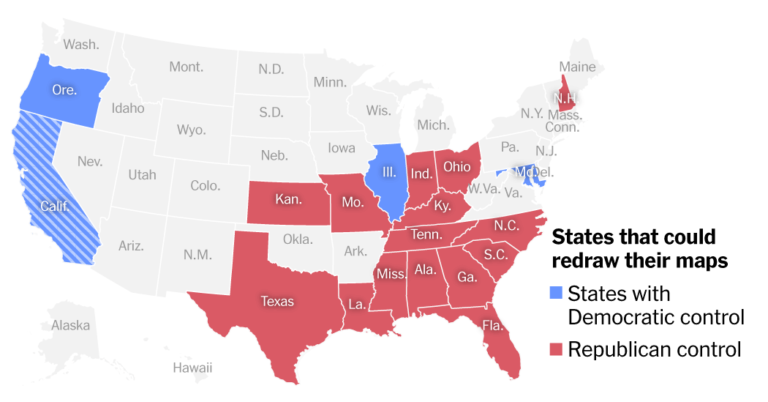The aggressive push by President Trump and Republicans in Texas to flip as many as five congressional seats by drawing new maps ahead of the midterm elections threatens to set off a nationwide redistricting arms race. But it is Republicans who have a clear advantage over Democrats in the total number of states that could redraw their maps.
The process of drawing new legislative maps — which is typically done at the beginning of every decade, after the census — varies from state to state. And not every state has the right conditions to participate in the emerging redistricting battle.
Redrawing a map in the middle of the decade without a court order is likely a highly partisan affair, requiring one party to control both the governor’s mansion and the statehouse. The state must have seats that could be drawn into a partisan advantage without running afoul of Voting Rights Act protections for communities of color. And it must also be one where the legislature holds the power to draw the maps.
Here’s how the list of states that could consider redistricting gets narrowed down.
States must have single-party control
15 with
Democratic control
26 with
Republican control
As the country has become more polarized, trifectas — when one party has control over the governor’s office and both chambers of the legislature — have become more common. Republicans currently hold 23 trifectas, while Democrats hold 15.
In rare cases, control of the legislature alone can give a party complete control over the redistricting process, either through specific state laws or through a supermajority, which enables the legislature to override a governor’s veto.
For example, in Kentucky, which has a Democratic governor, the Republican supermajority functions largely as a trifecta because it needs only a simple majority to override the governor’s veto.
In North Carolina, Republicans are a few votes shy of a supermajority in one chamber but still control the redistricting process because the state’s congressional maps are not subject to veto and therefore can be passed by a simple majority in the legislature.
States must also have split representation
While some highly polarized states are willing to join the redistricting fray, many are limited by simple math: They need a seat held by the opposing party that could be flipped through redistricting.
States with just one congressional seat — Alaska, Delaware, North Dakota, South Dakota, Vermont and Wyoming — have no way to change the map; it’s just the state’s borders.
In other states, one party controls all the congressional seats, leaving no room to maneuver. This is true of Connecticut, Hawaii, Maine, Massachusetts, New Mexico and Rhode Island, which have all-Democratic delegations, and Arkansas, Idaho, Iowa, Montana, Nebraska, Oklahoma, Utah and West Virginia, which have all-Republican delegations. (Although New Hampshire has an all-Democratic delegation, Republicans currently control its state government.)
Even where it looks as if a seat could be flipped, there are restrictions on how maps may be drawn. The federal Voting Rights Act requires states to preserve the rights of minority communities, effectively limiting the legislature’s ability to gerrymander. And in many states, there are simply too many voters from the opposing party to completely eliminate their representation in Congress, no matter how ruthlessly the lines are drawn.
And their legislatures must also draw the map
So let’s focus on states where one party has complete control of government but the opposing party holds some congressional seats. Can they start drawing new maps?
Not exactly.
In some states, an independent commission, rather than the legislature, draws the legislative map. These commissions were created, in many cases by referendum, to reduce the role of partisan politics from the redistricting process — essentially, to prevent the kind of gerrymandering that both parties are now considering.
Nine states have some form of redistricting commission: five Democratic trifecta states, two states with divided government, and two Republican trifecta states.
Congressional redistricting procedures, by state
In response, some Democratic states have embarked on efforts to work around their commissions.
In California, where voters approved an independent commission in 2010, Democratic leaders are moving to amend the State Constitution to empower the legislature to redraw the maps to head off Texas’ redistricting threat. That amendment process, if successful, could conclude in time for new maps to be installed before the 2026 midterms.
Democrats in New York have also threatened to change the state’s Constitution to disband its independent commission, in place since 2014. But because of a different state law, that change would not take effect until after the midterms.
The other Democratic trifecta states with a commission, Colorado, New Jersey and Washington, have not moved or pledged to return the redistricting power to the legislature.


